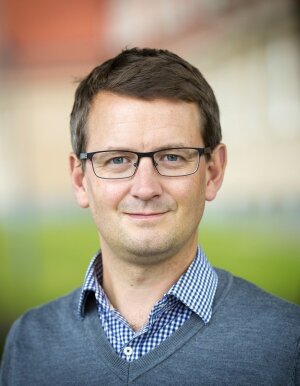
Portrait Prof. Dr. Daniel Brandell
Image: Prof. Dr. Daniel BrandellCurriculum Vitae
Daniel Brandell (born 1975) received his PhD in 2005 at Uppsala University, Sweden, on a thesis comprising Molecular Dynamics studies of polymer electrolytes for Li-ion batteries. After post-doctoral studies at Tartu University, Estonia, and Virginia Tech, USA, studying electrolyte systems for actuators and fuel cells using MD techniques, he returned to Uppsala to work on a project based on 3-dimensional microbatteries. Although he still is active in computational chemistry using both DFT calculations, MD simulations and FEM cell modelling, the core of his research activities today are experimental, and with a clear focus on Li-ion batteries and other ‘future’ battery chemistries such as Na-ion batteries, solid-state systems, Li-Sulfur, Organic batteries, etc. Current projects involve polymer electrolytes, interfacial studies, functional binders, organic electrodes, Li-S, battery ageing studies, etc. He has organized two main international conferences in these areas: the International Symposium on Polymer Electrolytes XV (Uppsala, 2016) and the Organic Battery Days (Uppsala, 2017). Brandell currently supervises >10 PhD students at Uppsala University, and has published above 120 peer-reviewed journal publications. He holds several research grants, including an ERC consolidator grant from 2017, and has many collaboration projects with industry, not least vehicle industry. In 2016, he was appointed Professor in Materials Chemistry at Uppsala University.
Learn more about Prof. Dr. Daniel BrandellExternal link
Abstract
Understanding superlithitiation of organic electrode materials by evolutionary algorithm DFT calculations
Daniel Brandell,1 Stéven Renault,2 Rodrigo Pereira de Carvalho,3 Cleber Marchiori,3 Carlos Moyses Graca Araujo3
1Department of Chemistry – Ångström Laboratory, Uppsala University, Box 538, 72121 Uppsala, Sweden
2ST2E, Institut des Matériaux Jean Rouxel (IMN), 2 Chemin de la Houssinière, 44300 Nantes, France
3Department of Physics and Astronomy, Materials Theory Division, Uppsala University, Box 516, 721 20 Uppsala, Sweden.
Computational tools striving towards machine learning techniques and artificial intelligence will provide enormous possibilities for materials design in the future, including the tailoring of organic electrode materials. In this presentation, we will highlight how combinations of evolutionary algorithms in combination with DFT calculations and AIMD simulations can be used to predict crystal structures and electrochemical behavior of organic electrode materials which are difficult to assess with conventional experimental techniques. We will focus this study on the so called ‘superlithiated’ organic electrode compounds [1], which can reach extreme capacities through mechanisms which remain largely unveiled. Using predicted crystal arrangements, the electronic structures and the voltage profile for the lithiation process are obtained, and are readily compared to experimental data. Molecular level computations and dynamic simulations provide further insights into the evolution of local structures during the lithitation and delithiation processes.
- S. Renault, V.A. Oltean, C.M. Araujo, A. Grigoriev, K. Edström, D. Brandell, Chem. Mater., 28 (2016) 1920
